Flea Bites on Dogs: What are They Like and How to Treat Them?
Recognizing and treating flea bites on dogs promptly is crucial for their comfort and protect their overall health. In this article, you will find detailed information on how to identify fleas, understand the risks associated with infestations, explore effective treatment options, and learn essential prevention strategies to safeguard your beloved dog’s health and well-being.
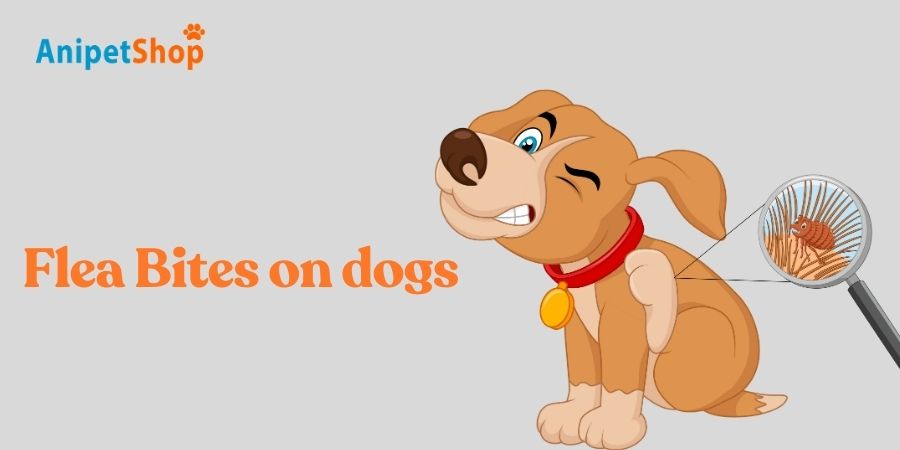
What do flea bites look like?
Flea bites on dogs typically appear as small, red bumps, often clustered together in groups. They can range in size from a pinprick to a small pea and may have a slightly raised appearance. Flea bites commonly exhibit a reddish-brown coloration due to irritation and inflammation. These bites are frequently found in areas where a dog’s fur is thinner, such as the abdomen, groin, armpits, and base of the tail. Fleas tend to gravitate towards warm, moist areas, making these spots ideal for infestation. Apart from the bites themselves, dogs may exhibit symptoms such as excessive scratching, chewing, or licking at the affected areas, leading to hair loss and skin damage. In severe cases, flea bites can trigger allergic reactions, manifesting as intense itching, swelling, and even dermatitis.
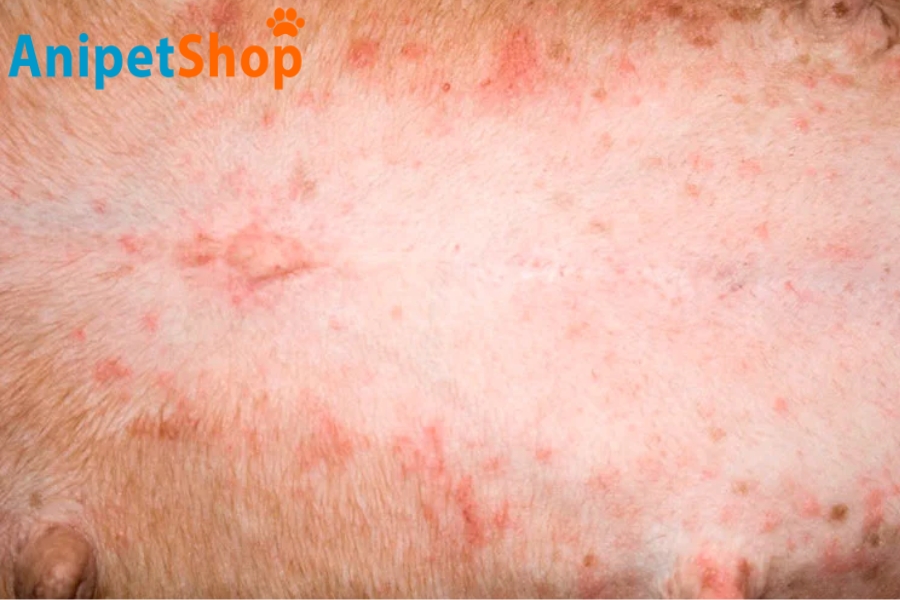
7 signs of dogs infested by fleas
If you’re uncertain about where to begin, consider these seven indications of fleas on dogs:
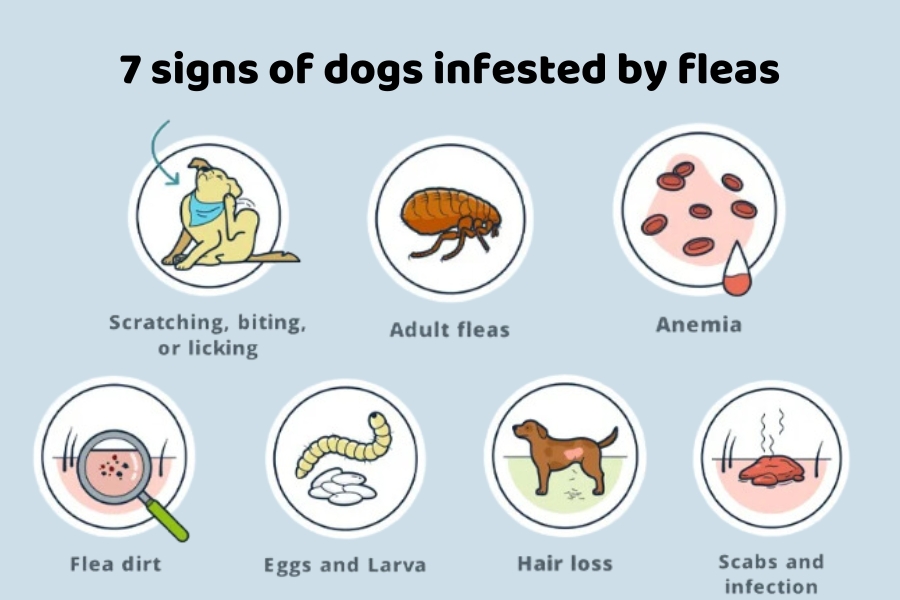
Scratching, biting, or licking
Scratching is typically observed as the dog attempts to alleviate discomfort caused by flea bites. Biting may occur as the dog tries to directly target and remove the fleas. Licking is another common behavior, often seen when dogs try to soothe irritated skin or remove flea saliva from their fur. If your dog is persistently scratching, biting, or licking, it’s advisable to inspect for signs of flea activity.

Adult fleas
When you part your pet’s fur and observe small, mobile specks resembling black pepper on their skin, it’s probable evidence of fleas. Adult fleas are readily discernible with the naked eye on your pet’s coat.
Flea dirt
Identifiable as tiny black specks on your dog’s skin, flea debris consists of digested blood particles—essentially, flea excrement. A simple test involves placing the suspected debris on a damp, white paper towel. If it transforms into a reddish-brown hue, unfortunately, your dog has fleas.
Eggs and larvae
While less conspicuous, you may also encounter flea eggs and larvae within your home environment. Following a blood meal, fleas deposit numerous minuscule, white eggs, which can be found in bedding, carpets, and furniture until they hatch into larvae.
Hair loss
A common consequence of flea bites is hair loss, attributed to the irritative properties of flea saliva prompting pets to scratch or bite for relief. Hair loss may be noticeable along your dog’s lower back, tail, and hind legs.

Anemia
Anemia often manifests as pale gums and diminished energy levels in pets, particularly in young dogs. This condition arises due to significant blood loss resulting from flea infestation. Fleas can ingest blood volumes up to 15 times their body weight, posing substantial health risks to your pet.
Scabs and infection
Flea bites typically manifest as small, red bumps on your dog’s skin, markedly smaller than mosquito or tick bites. These bites can become inflamed and prone to tearing upon excessive scratching, potentially leading to secondary infections.
Risks of fleas on dogs
1. Flea Allergy Dermatitis (FAD)
Flea Allergy Dermatitis (FAD) is a prevalent skin condition among pets, characterized by an allergic response to flea saliva. Remarkably, even a lone flea bite can provoke a severe reaction in susceptible dogs and cats. Symptoms include relentless scratching, biting, and licking of the skin, accompanied by hair loss and potential secondary skin infections. Management of FAD necessitates the elimination of fleas through rigorous control measures, coupled with anti-inflammatory treatment to alleviate discomfort.
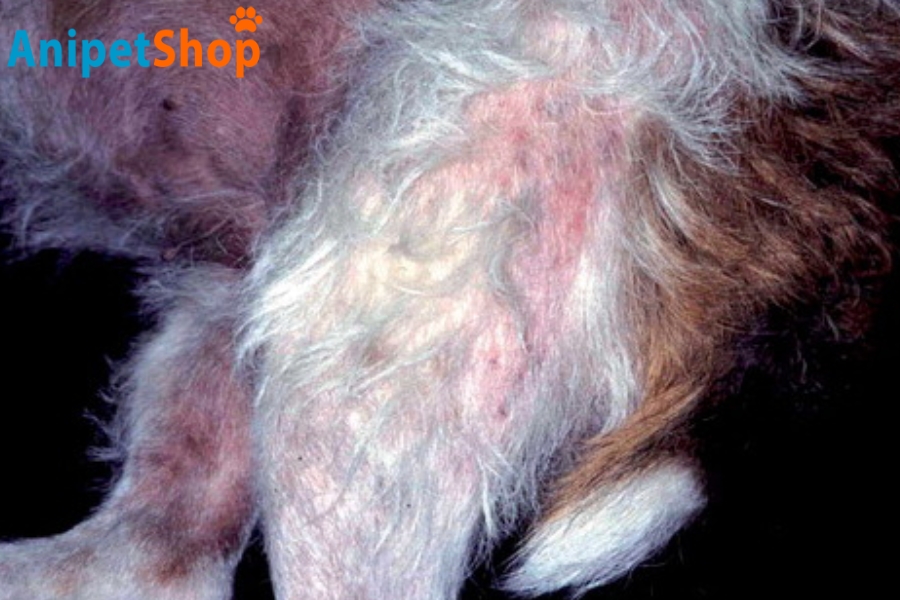
2. Anemia
Heavy flea infestations pose a significant risk of anemia, particularly in young, elderly, or immunocompromised pets, as they suffer blood loss from flea bites. Symptoms of flea-induced anemia include pale gums, weakness, lethargy, and in severe instances, potential fatalities. Managing this condition involves stringent flea control measures to eradicate the infestation, along with providing nutritional support to bolster the pet’s health.

3. Tapeworm Infection
Fleas serve as carriers for tapeworm larvae, posing a risk to pets who inadvertently ingest infected fleas while grooming. Upon ingestion, pets can become hosts to tapeworms, leading to various symptoms including the presence of tapeworm segments in feces or around the anus, weight loss, and occasional vomiting. Effective management of this issue involves administering deworming medications prescribed by a veterinarian, aiming to eliminate tapeworms from the pet’s system and prevent further infestation.
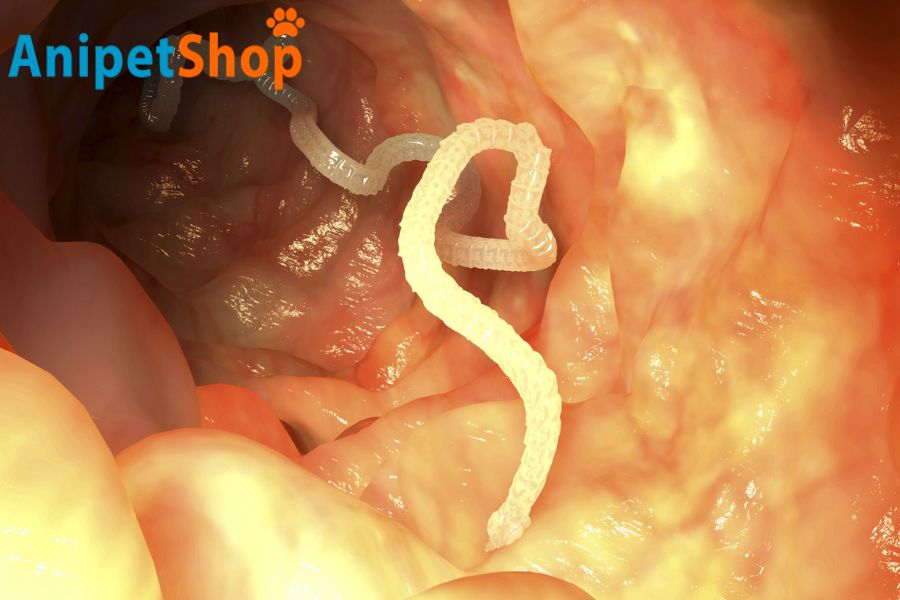
4. Bartonellosis
“Cat scratch disease,” also referred to as Bartonellosis, is a bacterial infection that can be transmitted to both cats and dogs via flea bites. Symptoms of this condition commonly include fever, vomiting, diarrhea, lethargy, and swelling of the lymph nodes. Administering antibiotics to combat the bacterial infection and providing supportive care to alleviate the associated symptoms and aid in the pet’s recovery.
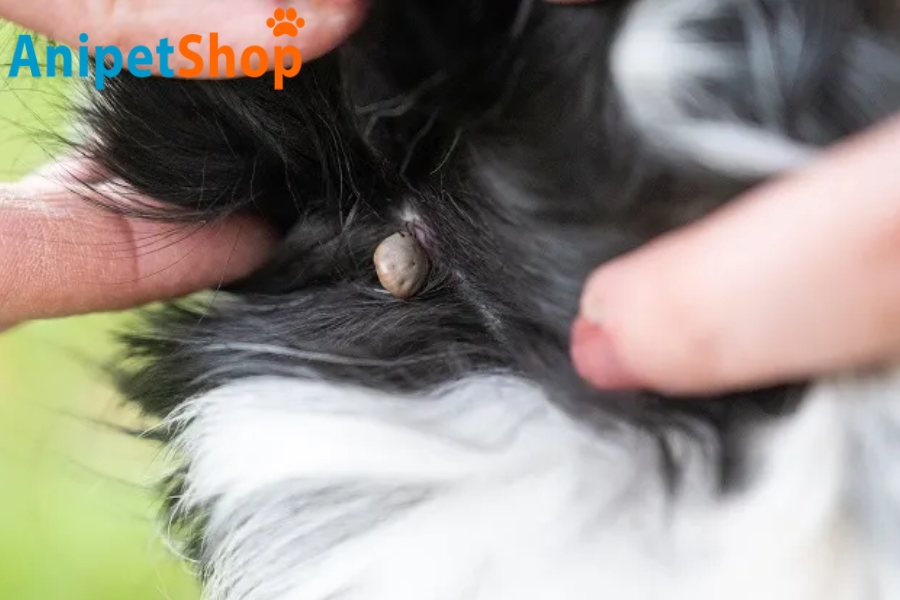
5. Flea Bite Anemia
Flea bite anemia is a condition akin to anemia, specifically resulting from the direct loss of blood due to flea bites. The symptoms and management of flea bite anemia are identical to those of regular anemia. Symptoms may include pale gums, weakness, lethargy, and in severe cases, potential fatalities. Management involves stringent flea control measures to eradicate the infestation, providing nutritional support to bolster the pet’s health.

6. Murine Typhus
This bacterial disease, transmitted by infected fleas, primarily targets rats but can infect cats, dogs, and humans. In humans, symptoms typically include fever, headache, rash, and muscle pain. Effective management includes administering antibiotics to infected individuals to combat the bacterial infection and alleviate symptoms.
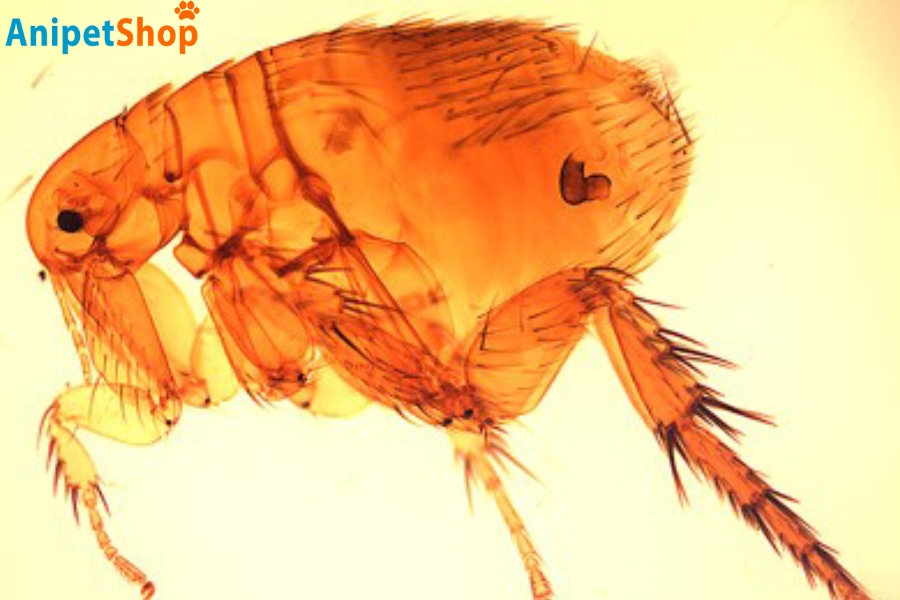
7. Plague
Although uncommon, fleas have the potential to transmit the plague to both humans and pets. This disease, caused by the bacterium Yersinia pestis, can lead to severe illness if left untreated. Symptoms typically include fever, weakness, and swollen lymph nodes. Swift action is crucial, with immediate medical intervention involving the administration of antibiotics being the primary course of management.

8. Flea Infestation in the Environment
Fleas pose a persistent challenge as they can infest various areas within homes, including bedding and outdoor spaces, resulting in recurrent exposure. Managing flea infestations requires a multifaceted approach. This includes seeking professional pest control services to effectively eradicate fleas from the environment, as well as implementing preventive measures such as regular vacuuming to remove flea eggs and larvae, washing bedding in hot water to eliminate fleas and their eggs, and treating pets with veterinarian-recommended flea preventatives to prevent re-infestation.

9. Psychological Stress
Pets burdened with heavy flea infestations often endure substantial discomfort and stress, profoundly impacting their overall well-being. To alleviate their suffering and promote a better quality of life, it’s essential to implement effective flea control measures. This involves promptly treating the pet with veterinarian-approved flea products to eliminate existing infestations and prevent future ones. Creating a calm and comfortable environment for the pet, free from the irritation caused by fleas, can contribute significantly to their overall happiness and health.

10. Transmission of Other Parasites
Fleas serve as vectors for various parasites and diseases, further complicating the health status of pets. Beyond causing direct discomfort, flea infestations can introduce additional health risks to animals. To effectively manage this complexity and safeguard the pet’s well-being, implementing a comprehensive parasite control strategy is essential. This includes regular use of veterinarian-recommended flea preventatives to keep flea populations in check and prevent transmission of other parasites and diseases.

How to treat fleas on dogs?
1. Treat the Dogs
Treating fleas on dogs is essential to alleviate discomfort, prevent potential health complications, and maintain their overall well-being.
-
- Topical Treatments: Apply a veterinarian-recommended flea treatment to your dog’s skin, usually between the shoulder blades or along the back. These treatments can kill adult fleas, larvae, and eggs.
Suggested Medications: Frontline Plus, Advantage II, K9 Advantix, etc.
-
- Oral Medications: Oral flea treatments are available that can kill fleas at various life stages. Some start working within hours and offer a month of protection.
Suggested Medications: NexGard, Bravecto, Comfortis, etc.
-
- Flea Shampoos and Dips: Bathing your dog with flea shampoo can provide immediate relief by killing fleas on contact. Flea dips are more concentrated treatments and should be used with caution under the guidance of a veterinarian.
Suggested Medications: Adams Plus Flea & Tick Shampoo, Sentry Flea & Tick Shampoo with Oatmeal, Hartz UltraGuard Flea & Tick Dip for Dogs and Cats, etc.
-
- Flea Collars: Some flea collars are designed to repel or kill fleas. Ensure you choose a collar that is safe and effective, as efficacy can vary widely among different brands.
Suggested Medications: Seresto Flea and Tick Collar, Scalibor Protector Band, BioSpot Active Care Flea and Tick Collar, etc.
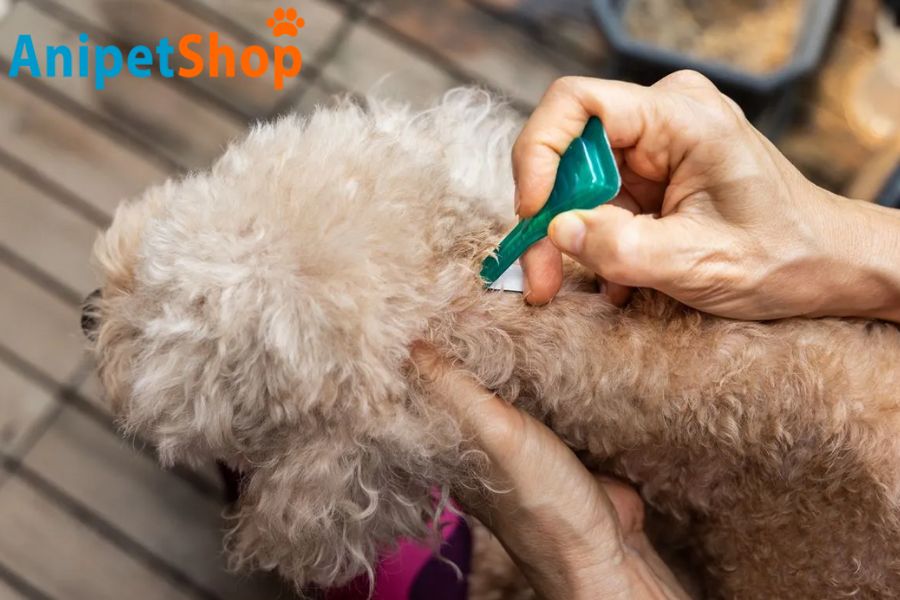
2. Treat the Indoor Environment
Treating the indoor environment is crucial to prevent fleas on dogs as it helps eliminate flea eggs, larvae, and adults hiding in carpets, furniture, and bedding, reducing the risk of re-infestation and ensuring a flea-free living space for both pets and humans.
-
- Vacuum Regularly: Vacuum carpets, floors, and furniture to remove fleas, eggs, and larvae. Pay special attention to areas where your dog spends a lot of time. Dispose of the vacuum bag or clean the vacuum container outside immediately after use.
- Wash Bedding: Wash your dog’s bedding, as well as any other washable items your dog frequently contacts, in hot water to kill fleas and eggs.
- Use Flea Sprays or Foggers: Insecticides designed for indoor use can help eliminate fleas from your home. Choose safe products for pets and humans, and follow the instructions carefully. It may be necessary to leave the house for a certain period after application.
- Consider Hiring a Professional: If the infestation is severe, professional pest control services can provide a more thorough treatment of your home.
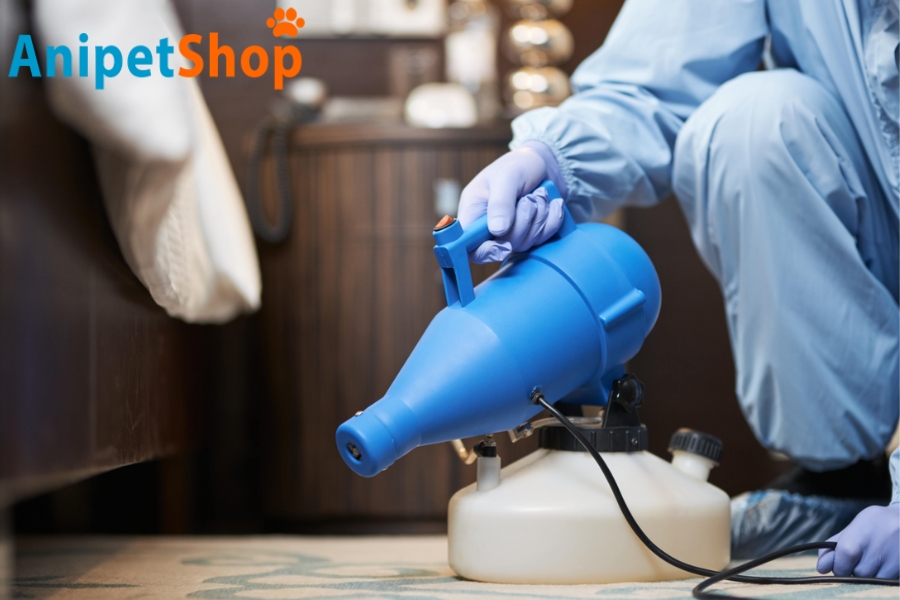
3. Treat the Outdoor Environment
Treating the outdoor environment is vital to prevent fleas on dogs as it helps eradicate flea populations in the yard, garden, and surrounding areas, minimizing the risk of exposure to fleas and reducing the likelihood of infestation in pets.
-
- Mow the Lawn Regularly: Mowing the lawn is essential as fleas thrive in tall grass. By keeping your lawn trimmed, you can effectively reduce flea populations and minimize the risk of infestation.
- Treat the Yard: Use outdoor flea treatments available in sprays or granules. Focus on shaded areas, decks, patios, and along fence lines where your dog spends time.
- Discourage Wildlife: To prevent fleas from entering your yard, it’s important to discourage wildlife as they can carry fleas. Utilize fencing or other deterrents to keep wild animals away from your property and reduce the risk of flea infestations.

Prevent Future Infestations
Preventing future infestations is crucial to avoid fleas on dogs as it helps maintain a flea-free environment, minimizing the discomfort and health risks associated with flea bites for both pets and humans.
-
- Regular Preventative Medication: Maintaining your dog’s regular flea preventative medication, as directed by your vet, is the most effective way to prevent future infestations. These medications provide ongoing protection against fleas, safeguarding your pet’s health and ensuring a flea-free environment in your home.
- Regular Checks: Check your dog for fleas, especially during warmer months when they’re most active. Use a flea comb to inspect areas like the neck, back, and tail base for signs of fleas, flea dirt, or eggs. If you find any, promptly take action such as administering flea treatment and consulting your vet.
- Maintain a Clean Environment: Regularly cleaning your home and yard helps prevent flea infestations. Vacuum carpets, rugs, and furniture indoors to remove fleas, and wash pet bedding in hot water. Outdoors, mow the lawn frequently, and remove clutter to discourage fleas.

Consult Your Veterinarian
Before initiating any flea treatment plan, it is essential to seek guidance from your veterinarian, particularly if your dog is very young, elderly, pregnant, nursing, or has underlying health conditions. Your veterinarian can provide tailored recommendations for the safest and most efficient treatment options to address your dog’s requirements.

FAQs
What does a flea bite look like on dogs?
Flea bites on dogs typically appear as small, red bumps, often clustered together in groups. They can range in size from a pinprick to a small pea and may have a slightly raised appearance. Flea bites commonly exhibit a reddish-brown coloration due to irritation and inflammation.
How do I treat flea bites on my dog?
Treating flea bites on your dog involves addressing both the bites themselves and eliminating fleas from their environment. Topical treatments such as medicated shampoos, sprays, or ointments can help alleviate itching and soothe irritated skin. Additionally, oral medications prescribed by a veterinarian may be necessary for severe infestations.
What kills fleas on dogs instantly?
While there’s no instant solution to killing fleas on dogs, several products and methods can effectively eliminate fleas over time. Flea treatments such as spot-on treatments, oral medications, flea collars, and flea dips can help eradicate adult fleas on your dog. Additionally, using flea preventatives and regularly cleaning your dog’s living environment, including bedding and carpets, can aid in flea control and prevention.
What can be mistaken for flea bites on dogs?
Several skin conditions and allergies can be mistaken for flea bites on dogs. These include allergies to food, pollen, or other environmental factors, as well as skin infections or parasitic infestations such as mites or ticks.
Conclusion
Addressing fleas on dogs is vital for their well-being. Recognizing signs, treating bites promptly, and implementing prevention methods are crucial steps. Through proactive measures and timely intervention, we can ensure our furry friends remain healthy and comfortable, free from the risks and discomfort associated with flea infestations.
Lily Watson is an author specializing in veterinary care in Australia. With a profound passion for animal welfare and a solid foundation in veterinary science, Lily has dedicated herself to disseminating valuable knowledge and information for both pet owners and professionals in this field.

